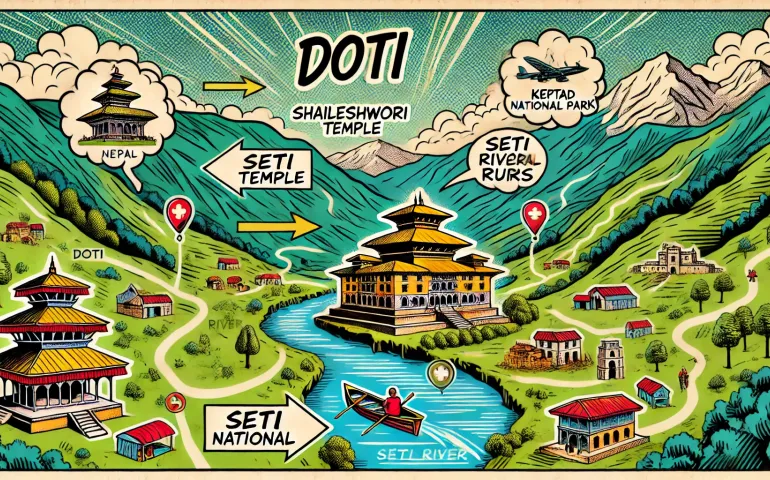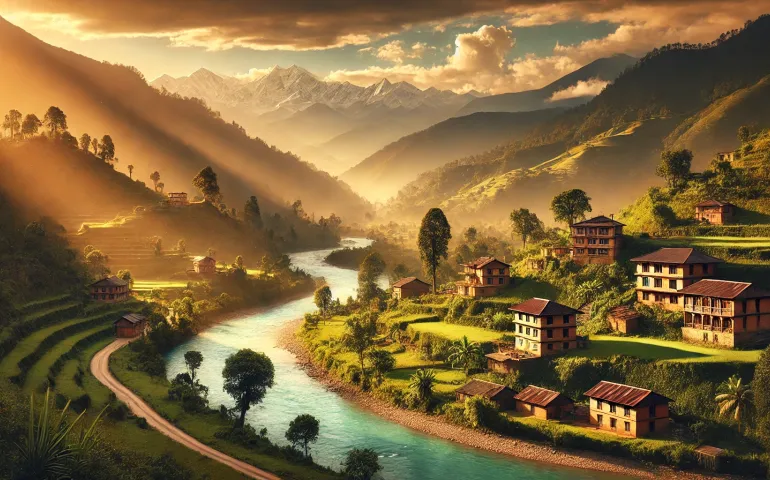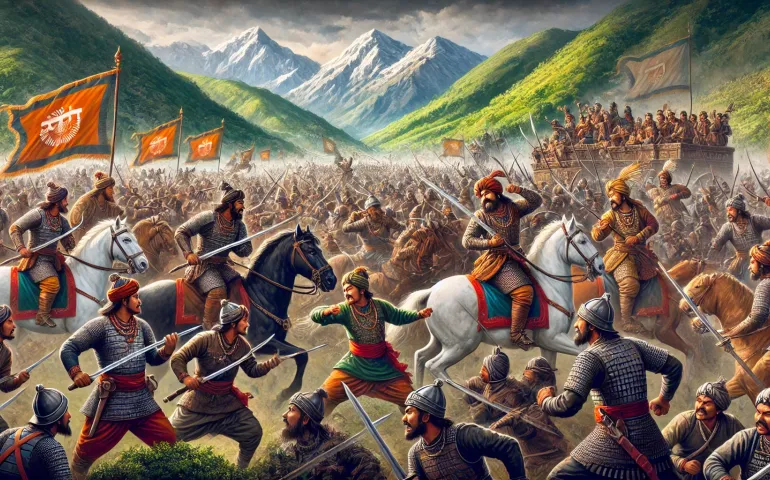About Place
- "A hidden gem in Nepal, untouched by mass tourism."
- "Rich in ancient history and vibrant local culture."
- "Breathtaking landscapes and serene natural beauty."
Reasons to Visit
- Historical Significance: Doti is home to some of the oldest historical sites in Nepal, with roots dating back to the ancient Doti Kingdom. The region boasts ancient temples like Shaileshwori Temple and the ruins of Doti Palace, providing a glimpse into the medieval history of Nepal. The cultural richness and historical importance make it a unique destination for history enthusiasts.
- Natural Beauty: Nestled in the hills of the far-western region of Nepal, Doti offers stunning landscapes, including lush green hills, dense forests, and pristine rivers. The natural beauty is accentuated by panoramic views of the Himalayan range, making it an ideal spot for nature lovers and adventure seekers. The serene environment provides a perfect escape from the hustle and bustle of city life.
- Cultural Experience: Doti's cultural heritage is as rich as its history. The region is inhabited by diverse ethnic groups, each contributing to a vibrant cultural tapestry. Visitors can experience traditional Nepali lifestyles, participate in local festivals, and enjoy folk music and dances. The warm hospitality of the local people adds to the charm, offering an authentic cultural experience.
Visa
- Tourist Visa Requirement: Travelers from most countries need a tourist visa to enter Nepal.
- Visa-on-Arrival: Available at Tribhuvan International Airport in Kathmandu and certain land border crossings.
- Alternative Application: Visas can also be obtained from Nepalese embassies and consulates abroad.
- Passport Validity: Passport must be valid for at least six months from the date of entry.
Travel Expenses
Travel to & from destination:
Estimated round-trip airfare from Kathmandu to Doti: $150 per person. Total for a couple: $300.
2. Hotel cost:
Average cost per night: $50. For a 3-night stay: $150 per room. Total for a couple: $300.
3. Food cost:
Average meal cost: $10 per person. Total for lunch and dinner for 3 days for a couple: $120.
4. Activity cost:
Entry fees and local guide costs for temples, parks, and museums: $50 per person. Total for a couple: $100.
5. Near destination travel cost:
Rented car for local travel: $30 per day. Total for 3 days: $90.

Best Itinerary
Day 1:
Arrive in Doti, settling into your accommodation, such as the charming local guesthouses that offer a comfortable stay. In the morning, explore Shaileshwori Temple, a significant religious site. Spend the afternoon hiking to the nearby hills, soaking in the natural beauty and panoramic views. For lunch, try traditional Nepali cuisine at a local eatery like Hotel Doti Palace. In the evening, visit the local markets and enjoy a traditional dinner at Doti Kitchen, experiencing the local flavors and hospitality.
Day 2:
Start your day with a visit to the ruins of Doti Palace, immersing yourself in the history of the ancient Doti Kingdom. Afterward, head to the Seti River for a peaceful riverside walk. Lunch at Riverside Restaurant offers local delicacies with a scenic view. In the afternoon, visit the local museum to learn more about Doti's cultural heritage. Dinner at Heritage Restaurant, featuring a menu of traditional dishes, rounds off the day. A nighttime stroll through the tranquil town provides a perfect end to the day.
Day 3:
Take a day trip to Khaptad National Park, an area known for its biodiversity and natural beauty. Explore the park’s trails, spotting wildlife and enjoying the lush landscapes. Pack a picnic lunch or dine at the park's small canteen. Spend the evening at leisure, reflecting on the day's experiences. Return to Doti for a farewell dinner at a renowned local restaurant, such as Doti Delight, savoring the flavors of the region.

Safety Tips
- Always carry a copy of your passport and visa.
- Stay hydrated and carry bottled water.
- Respect local customs and traditions.
- Keep your belongings secure and avoid displaying valuables.
- Use reputable transport services.
- Stay informed about the local weather.
- Avoid traveling alone at night.
- Learn basic local phrases for communication.
- Have emergency contacts saved on your phone.
- Purchase travel insurance.
Flights
- Airlines: Nepal Airlines, Buddha Air
- Estimated Cost: $150 per person round trip
- Duration: Approximately 1 hour from Kathmandu to Doti
Hotels
- Hotel Doti Palace
- Shaileshwori Guesthouse
- Doti Delight Hotel
- Seti River Resort
- Heritage Lodge
Contacts
- Indian Embassy in Nepal:
- Phone: +977-1-4410900
- Email: consular@indianembassy.org.np
- Police: 100
- Ambulance: 102
- Firefighters: 101
Country
Closet Airport
- Dhangadhi Airport (about 3 hours drive from Doti)
Nearest City
- Kathmandu
Heritage Sites
- Shaileshwori Temple
Airlines
- Nepal Airlines
- Buddha Air
Currency
- Nepalese Rupee (NPR)
Languages Spoken
- Doteli
- Nepali
Real Story
The late 18th century was a period of significant upheaval and transformation in Nepal, marked by the ambitious unification campaign led by King Prithvi Narayan Shah. Among the many regions that played a crucial role in this campaign was Doti, a historical kingdom with a rich cultural heritage and strategic importance. The Battle of Doti stands out as a pivotal event in the broader context of Nepal’s unification.
Background
Doti was one of the principalities in the far-western region of Nepal, ruled by the Raikas, a powerful dynasty with roots tracing back to the Katyuri kings of Kumaon. The kingdom of Doti, with its capital at Dipayal, controlled significant trade routes and had considerable influence over the surrounding territories. It was strategically important due to its location and resources, making it a key target for Prithvi Narayan Shah’s unification efforts.
Prithvi Narayan Shah ascended the throne of the small kingdom of Gorkha in 1743 AD. His vision extended beyond his immediate domain, aiming to unify the various fragmented kingdoms and principalities into a single, cohesive nation. The campaign to unify Nepal was driven by the need to consolidate power, protect against external threats, particularly from British India, and create a stronger, more resilient state.
The Battle
The unification campaign advanced steadily from the east to the west. By the late 18th century, Prithvi Narayan Shah’s forces had successfully annexed several key regions, and their attention turned towards Doti. The Raikas of Doti, led by their king, were known for their valiant defense and strategic acumen. The battle for Doti was not just a military engagement but also a clash of wills between the ambitious Gorkha king and the resilient Raikas.
The Gorkhali forces, well-trained and motivated by the vision of unification, marched towards Doti. The Raikas, aware of the impending threat, fortified their positions and prepared for a protracted defense. The hilly terrain of Doti, characterized by dense forests, rivers, and rugged landscapes, provided a natural advantage to the defenders.
The battle commenced with skirmishes and strategic maneuvers as both sides vied for control of key positions. The Gorkhali army, led by experienced generals, utilized their superior tactics and better coordination to gradually wear down the Doti defenses. Despite the fierce resistance put up by the Raikas, the tide of the battle began to turn in favor of the Gorkhalis.
Key Turning Points
Several key moments defined the battle. The capture of important fortifications around Dipayal by the Gorkhali forces disrupted the defense lines of Doti. The Gorkhalis employed a combination of direct assaults and siege tactics, cutting off supply routes and weakening the resolve of the defenders. The morale of the Raikas began to wane as their resources dwindled, and the relentless pressure from the Gorkhali army took its toll.
Another significant factor was the diplomatic efforts by Prithvi Narayan Shah to win over local chieftains and influential leaders within Doti. These alliances helped undermine the unified resistance of the Raikas, further tipping the scales in favor of the Gorkhalis.
Outcome and Impact
The eventual fall of Doti to the Gorkhali forces was a decisive victory in Prithvi Narayan Shah’s unification campaign. The annexation of Doti not only expanded the territorial reach of the Gorkha kingdom but also sent a strong message to other principalities about the inevitability of unification under the Shah dynasty.
The integration of Doti into the growing Gorkha empire was marked by the establishment of administrative controls and efforts to integrate the local population into the new political framework. Prithvi Narayan Shah’s policy of cultural assimilation and respect for local traditions helped ease the transition and reduce resistance from the local populace.
Cuisine
Doti, a district in the far-western region of Nepal, boasts a unique culinary tradition that reflects its cultural heritage, agrarian lifestyle, and local ingredients. The cuisine of Doti is characterized by its simplicity, robust flavors, and the use of locally sourced ingredients, making it both delicious and nutritious. Here are some of the key highlights of Doti's cuisine:
1. Dhido:
Dhido is a staple food in Doti and many other parts of Nepal. It is a thick porridge made from buckwheat, millet, or corn flour. The preparation involves stirring the flour into boiling water until it reaches a smooth, dough-like consistency. Dhido is typically served with Gundruk (fermented leafy greens), vegetable curries, or meat dishes. It is highly nutritious and gluten-free, making it a healthy option for many.
2. Sukuti:
Sukuti is a popular snack and ingredient in various dishes. It consists of dried meat, usually buffalo or goat, which is marinated with spices and then sun-dried or smoked. Sukuti can be eaten on its own as a chewy, flavorful snack or added to curries and stir-fries for an extra burst of flavor. The drying process preserves the meat, making it a convenient source of protein.
3. Gundruk:
Gundruk is a traditional fermented leafy green vegetable, often made from mustard, radish, or cauliflower leaves. The leaves are wilted, crushed, and tightly packed in a container to ferment for several days. Once fermented, they are sun-dried and stored for later use. Gundruk is typically used in soups, stews, and curries, imparting a tangy and slightly sour flavor to the dishes.
4. Thukpa:
Thukpa is a hearty noodle soup that is particularly popular in the mountainous regions of Nepal, including Doti. It is made with hand-pulled noodles, vegetables, and sometimes meat, all simmered in a flavorful broth. Thukpa is often seasoned with garlic, ginger, and a variety of spices, providing a warming and satisfying meal, especially during the colder months.
5. Sel Roti:
Sel Roti is a traditional Nepali sweet treat that is commonly prepared during festivals and special occasions. It is a type of rice doughnut made from rice flour, sugar, and water, which is deep-fried until golden and crispy. Sel Roti is enjoyed as a snack or dessert and is often accompanied by tea.

Culture and History
Cultural Overview:
Doti, located in the far-western region of Nepal, is a district rich in culture and tradition. The cultural heritage of Doti is deeply rooted in its history, with influences from various ethnic groups, primarily the Khas and Doteli people. The region's cultural identity is reflected in its language, festivals, music, dance, and daily life.
Language and Ethnicity:
The primary language spoken in Doti is Doteli, a dialect of the Nepali language, which is part of the Western Pahari group. The Doteli people are known for their warm hospitality and adherence to traditional lifestyles. The ethnic composition includes other groups such as the Tharu and Chhetri, each contributing to the cultural mosaic of the region.
Festivals and Traditions:
Festivals play a significant role in the cultural life of Doti. Major festivals include:
- Gaura Parva: A prominent festival dedicated to the goddess Gauri, celebrating marital fidelity and familial prosperity. It involves various rituals, including fasting, singing traditional songs, and performing dances.
- Maghi (Maghe Sankranti): Celebrated in mid-January, marking the New Year according to the Tharu calendar and the end of the winter solstice. The festival is characterized by feasting, dancing, and traditional games.
- Dashain and Tihar: National festivals celebrated with great enthusiasm, involving family gatherings, offerings to deities, and cultural performances.
Music and Dance:
Traditional music and dance are integral to Doti's cultural heritage. Deuda, a folk dance and song form, is especially popular. Deuda songs are usually performed during festivals and social gatherings, characterized by their call-and-response style and rhythmic clapping. The dance involves participants holding hands and forming a circle, moving in sync with the music.
Art and Craft:
The artisans of Doti are skilled in various traditional crafts. Handicrafts such as weaving, pottery, and wood carving are common. These crafts are not only a source of livelihood but also an expression of the region's artistic heritage.
Daily Life:
The people of Doti lead an agrarian lifestyle, with farming being the primary occupation. The traditional way of life is evident in their attire, cuisine, and housing. Houses are typically made of stone and mud with thatched roofs, blending seamlessly with the natural environment.
Historical Overview:
Doti has a rich historical legacy that dates back to ancient times. It was once a part of the Doti Kingdom, believed to have been established around the 13th century by Niranjan Malla Dev, a descendant of the Katyuri dynasty of Kumaon. The kingdom played a crucial role in the political landscape of the region before the unification of Nepal.
Ancient Kingdom:
The Doti Kingdom was one of the many principalities in the far-western region of Nepal. The rulers of Doti, known as the Raikas, had a significant influence over the surrounding areas. The kingdom's capital was Dipayal, a town that still serves as the administrative center of Doti district.
Strategic Importance:
Due to its strategic location, Doti was a focal point during the unification campaigns led by Prithvi Narayan Shah in the 18th century. The region witnessed numerous battles between the forces of the Gorkha kingdom and the local rulers. The successful annexation of Doti by the Gorkhali forces marked an important milestone in the formation of modern Nepal.
